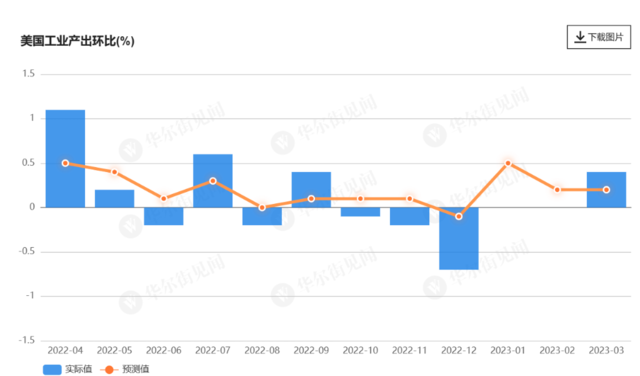风萧萧_Frank
以文会友Inflation cooled to 5% in March, but consumer pain is set to linger
Experts say that even as price growth slows, it won’t reverse outright, which is likely to be of little solace to consumers right now.
Consumer prices climbed 5% in March, the Bureau of Labor Statistics reported Wednesday, down from 6% in February.
The latest inflation reading represents the ninth-straight month of easing price growth on an annual basis, and is down from a 9% high last June. On a month-over-month basis, prices increased 0.1% — the lowest reading since last July.
But it's still well above the Federal Reserve’s 2% target. Among the key categories still seeing outsized price growth are food, which climbed 8.5% from March 2022 to March 2023, and rent, which hit 8.3% growth, its largest-ever 12-month increase.
As a result, cooling inflation won't prove much solace to consumers, who can still expect to feel the pinch in their pocketbooks for a while longer.
Because inflation numbers are closely tied to the Federal Reserve's decisions about how high interest rates should be, a majority of investors are betting the Fed will raise rates by 0.25% again at its next meeting May 3.
Analysts say some of the key drivers of the post-pandemic spike in inflation, like supply chain issues and the elevated food and energy prices spurred in part by the war in Ukraine, are abating. But the flames of inflation are nevertheless being fanned by a still-hot job market, which has added 1 million positions in 2023.
It's an unfortunate trade-off: Workers who feel secure about their jobs are comfortable spending, which creates demand in the economy that can drive price surges.
By raising interest rates, the Federal Reserve hopes to make investing, borrowing and ultimately hiring more costly for businesses.
"There's an imbalance in demand and supply," said Greg McBride, Bankrate's senior vice president and chief financial analyst. "Now, that imbalance still stems from an outsized level of demand. Unemployment is at a 50-year low, and spending is quite strong, and it’s that demand that the Fed is aiming to address by raising interest rates."
In a recent note to clients, Seema Shah, the chief global strategist of Principal Asset Management, said U.S. inflation is expected to decelerate further through this year, "but only very slowly."
"Slower economic activity and a looser labor market" — most likely meaning an unemployment rate higher than the current 3.5% — "will be necessary to fade these pressures," Shah said.

Cost of food and shelter remain stubbornly high
Food and rent are among the categories that continue to have the largest price increases. In February, food prices climbed about 10%, continuing a run of double-digit 12-month increases that stretch back to May.
The same month, rents had their largest one-month increase on record, climbing 8.2%. Rent data is considered a "lagging" indicator, meaning surveys are slower to capture real-time changes because most leases are at least 12 months long. Other data from Realtor.com shows rent growth peaked sometime around winter 2021-22.
Indeed, prices are cooling substantially in other areas of the economy. While gas prices have climbed more than 13 cents over the past month, to $3.61 a gallon, they are still below the $4 levels of a year ago.
Wage growth is slowing
Meanwhile, wage growth has begun to show significant declines after it experienced bumps during the pandemic. According to data published by Goldman Sachs, workers' earnings are growing at less than 5% per quarter, down from as much as 8% in 2021. And wage growth for lower-paid workers, represented by leisure and hospitality positions, has declined to less than 6% after having surged to about 18% in the winter of 2021-22.
“We see the slowdown in wage growth alongside a further decline in the unemployment rate as supportive of our long-standing view that much of the peak wage growth overshoot was driven by temporary factors” — mostly pandemic-related causes like stimulus checks, reduced labor supply and energy price spikes that led workers to demand higher pay, Goldman Sachs economist David Mericle wrote in a note to clients Friday.
“All of these have fully or partially faded on their own and appear to have solved much of the problem of lowering wage growth to the 3.5% pace that we estimate would be compatible with 2% inflation," Mericle continued.
As a result, he said, there is less urgency for the Fed to continue aggressively hiking interest rates.
But McBride of Bankrate said that even as inflation continues to slow, it won't reverse outright. Only in rare instances — and not even during some recessions — do prices decline on an annual basis.
The bottom line: The higher prices that have become a hallmark of the post-pandemic U.S. economy are here to stay.
"The hoped-for moderation in inflation is not something that means prices will fall. It just means they don’t rise as fast," McBride said.
"The inflation we’ve seen over the past couple of years has increased household expenses and essentially set a new base, and those expenses are not going to fall in a broad-based way. They just might not go up as fast."
Rob Wile is a breaking business news reporter for NBC News Digital.
US manufacturing near three-year low; casts a shadow over economy
https://www.reuters.com/markets/us/us-manufacturing-sector-weakest-nearly-three-years-march-ism-2023-04-03/
- Summary
- Manufacturing PMI at 46.3 in March versus 47.7 in February
- New orders index tumbles to 44.3 from 47.0 in February
- Employment contracts; prices gauge declines
WASHINGTON, April 3 (Reuters) - U.S. manufacturing activity slumped in March to the lowest level in nearly three years as new orders plunged, and analysts said activity could decline further due to tighter credit conditions.
The Institute for Supply Management (ISM) survey on Monday showed all subcomponents of its manufacturing PMI below the 50 threshold for the first time since 2009. Some economists said this suggested a recession was around the corner, while others said much would depend on the services sector, whose PMI remains consistent with a growing economy.
Federal Reserve rate hikes to fight inflation have raised borrowing costs and cooled demand for goods.
"Manufacturing is pulling back, but the service sector was still chugging along in February," said Chris Low, chief economist at FHN Financial in New York. "As long as it remains well above 50 when reported on Wednesday, the broad economy should be just fine. Nevertheless, the health of manufacturing is related to the health of the overall economy."
The ISM's manufacturing PMI fell to 46.3 last month, the lowest level since May 2020, from 47.7 in February. Outside the COVID-19 pandemic, it was the weakest reading since mid-2009.
消费、制造业全线下滑,美国经济正“逐步冷却”
华尔街见闻 2023年04月15日 15:19
https://finance.sina.com.cn/stock/usstock/c/2023-04-15/doc-imyqmynm2502498.shtml?cref=cj
即使如此,美联储还要再加息25基点?在通胀和借贷成本高企的背景下,美国消费和制造业活动均显著放缓。
其中,3月零售额下滑幅度为四个月来最大,主要是因为加油站收入下滑和汽车经销商业务放缓。制造业产出降幅也超过预期,尽管前两个月的数据有所修正,使得第一季度的生产仍略有增长。
结合近期通胀数据释放出的信号,隔夜公布的经济数据表明,美国经济正逐步走向“冷却”。尽管如此,交易员仍预计美联储5月份将再次加息25基点,但也有一些政策制定者最近暗示对暂停加息持开放态度。
美国消费正加速萎缩,工业活动延续放缓趋势
美国人口普查局周五公布的数据显示,美国3月零售销售环比-1%,远低于市场预期的-0.4%。

不过,除去汽车和汽油后,美国3月零售销售环比减少0.3%,高于预期的-0.5%。
另外,对照组零售额——用于计算国内生产总值——不包括食品服务、汽车经销商、建筑材料商店和加油站的零售额降幅也低于预期。
周五晚间,美联储公布的数据显示,美国制造业产出环比-0.5%,远低于市场预期的-0.1%,这也是该指标今年以来首次出现下降。

制造业产出下滑,主要是因为企业在借贷成本上升的情况下显示出缩减投资计划的迹象。
不过,1月制造业产出环比增速由0.1%上修至0.6%。
3月工业产出环比增长0.4%,略高于预期的0.2%,前值也从0%上修至0.2%。

“今天上午数据的共同主题是,第一季度情况相对强劲和良好,但进入第二季度时明显放缓,”法国巴黎银行(32.56, 0.82, 2.58%)高级美国经济学家Yelena Shulyatyeva表示,“这一点你可以在对照组零售额中看到,你可以在工业生产数据中看到这一点,尤其是在制造业。”
高通(120.16, -0.97, -0.80%)胀下,经济依然压力山大
根据最近公布的物价数据,通胀出现放慢下行的趋势,经济仍面临巨大的压力。
美国密歇根大学公布的4月调查初值显示,消费者预计未来一年的通胀率从3月的3.6%升至4.6%,创将近两年来最大升幅,未来五年通胀预期连续五个月企稳于2.9%。消费者的未来一年汽油预期价格涨至六个月来高位,未来五年预期价处于近一年来高位。
评论称,消费者充分意识到通胀已从高峰回落,但高物价仍使他们对财务状况感到不安。还有人认为,整体通胀之前已经因汽油价格下跌而回落,但这种趋势可能很快反转,更令人担忧的是,剔除食品和能源的核心通胀顽固居高不下,这是美联储可能将更高利率持续更久的风险所在。
正如评论所言,本周早些时候公布的CPI数据显示,住房压力下核心CPI同比反弹维持高位,再显通胀粘性。
PPI数据则带来了更多好消息:整体和核心PPI增速均低于预期,前者同比增速创逾两年来最低纪录,环比增速也创下近三年来最低纪录。
但令人不得不警惕的是,OPEC+月初宣布的大规模减产可能会继续放缓通胀下行的趋势。
德意志银行经济学家Justin Weidner表示,美联储官员“将更多地关注这一事实,即通胀预期仍存在一定不确定性,以及他们不能将向好的信号视为理所当然的事实。





